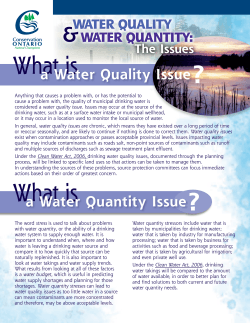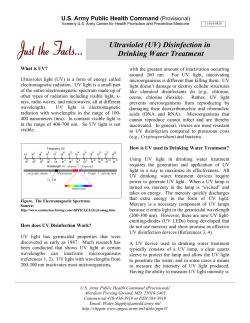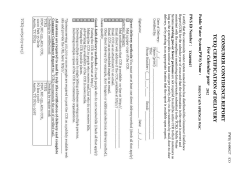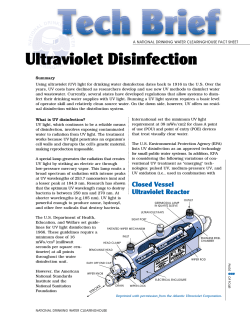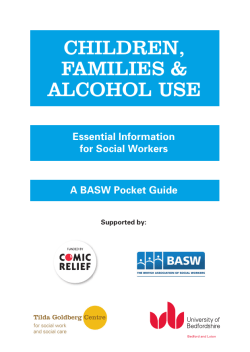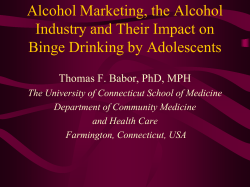
Chandler Utilities
Chandler Utilities Chandler, Indiana 47610 PWSID #5287002 Year 2012 Committed To Providing Safe, Clean Drinking Water WATER QUALITY REPORT Chandler Utilities is managed by the Chandler Town Council. The Chandler Town Council meets on the 1st and 3rd Mondays each month. Council meetings are held at the Chandler Community Center at 7:00 p.m. Utility Maintenance Facility 925-6213 Water Treatment Plant 853-5303 Billing Questions 925-6882 Utility Locates 1-800-382-5544 After Hours Emergencies (812) 483-1610 Utility Maintenance Facility 101 Constitution Ct. Chandler In. 47610 Chandler Town Hall 417 E. Jefferson St. Chandler In. 47610 Water Treatment Facility 9744 Pollack Ave. Newburgh In. 47630 The Town of Chandler is supplying the enclosed information in hope that any questions you may have can be answered. If after reading the information, you still have questions, you may contact any of the above numbers and we’ll be glad to discuss any issues you may have. You may also contact the Environmental Protection Agency by calling their Safe Drinking Water Hotline at (800) 426-4791. The Chandler Water Utility constructed a new treatment facility in 2011. The new facility provides for better treatment, more capacity and continuous monitoring and alarm systems to insure an uninterrupted service. With the upgrades and improvements to the well field, Chandler now has a long term plan to provide needed water for the growing area. Chandler has also been involved in water main relocation projects which have caused numerous issues in the system. These projects have caused low water pressure, higher chlorine levels and discolored water. We thank you for your patience during these times and hope that we have addressed the problems when needed. The water distribution system has many items that can be damaged which can create problems for the Utility and/or the customer. Water meter wells, located on each site, are used each month for billing and in the case of an emergency need to be accessed to turn off the water service. Customers should not access the meter well without approval from the Utility office. Each user can help by keeping the top of the meter well closed, clear of obstructions and not allowing damage to the top area. Any damages should be reported immediately. Fire hydrants are installed to fight fires and to perform routine maintenance on the system. A three-foot area around the hydrant must be kept clear at all times. This allows for maintenance on the hydrant and in the case of a fire the hydrant can be found quickly and fire hoses can be hooked up without interference. Utility personnel and firemen are the only authorized individuals allowed to operate a hydrant. Any other use should be reported to the Utility. The Chandler Water Utility maintains a critical water user list. This list is maintained in order to contact medical facilities and customers with medical concerns that require an uninterrupted, uncorrupted water source. To insure the list is current, any business or customer who falls in this category should contact (812) 925-6213 with their name, address and phone number in the event a situation should occur that would jeopardize the water service. The Chandler Water Utility consists of many properties and fixtures, which cover a large area. Even with security and alarm systems in place it still requires the assistance of citizens to monitor and safeguard the operation. Anytime there are suspicious activities around any Utility property, please contact the Utility or a law enforcement agency as quickly as possible. The Chandler offices often receive calls concerning discolored water. Many of these calls are not due to the water but due to homeowners with water softeners. Softeners must be maintained and if removed from service need to be disconnected from the plumbing. If you have questions feel free to contact our maintenance facility. As always, the Chandler Water Department is always pleased to provide any information or to answer any questions about our water source, water treatment and distribution system in order to help educate our users and to help them understand the water utility. Please feel free to contact us at the above numbers or visit our web site at TownofChandler.org. (1) The Environmental Protection Agency (EPA) and the Indiana Department of Environmental Management (IDEM) ensure that the uniform standards set by the Safe Drinking Water Act are met by every treatment facility. These Primary Drinking Water Standards, which are set to protect public health, are subject to maximum contaminant levels (MCL’s). Some standards are Secondary Drinking Water Standards that are aesthetic recommendations for the appearance, taste and odor of the water. Some contaminants are Unregulated Contaminants that require monitoring but do not have a MCL set. Although drinking water is expected to contain small amounts of some contaminants, the presence of these do not necessarily indicate that the water poses a health risk. Every step is taken to limit the contaminants that may be in the water and utility personnel run daily tests for chlorine, hardness, Ph, fluoride, turbidity, iron and manganese. We also send 15 samples per month to the state for bacteriological testing. We also test on a regular basis for radionuclides, lead and copper, inorganic compounds, volatile organic compounds and synthetic organic compounds. These total to over 100 items that are tested by the utility on a regular basis. Most of these contaminants are tested by independent laboratories due to the complexity of the testing. All of the test results along with our daily operations records are sent to the state each month for their review. In the year 2012, all the contaminants that were tested were below the limits set by the regulatory agencies. With certified operators, continous training and monitoring by IDEM and the EPA, the Town of Chandler is committed to providing the cleanest, safest and most efficient water supply possible to its customers. A Source Water Assessment was performed on 08/24/07 for the groundwater wells serving the utility. It was determined that the wells vulnerability to contamination was moderately high due to the thin clay thickness over the aquifer and the surrounding land use. Even with this determination, the Chandler Water Utility, through its Wellhead Protection Plan, will take all steps needed to insure the quality of its water source is not compromised. Details of the assessment are available through the utility maintenance facility. Sources for all drinking water (both tap water and bottled water) include rivers, lakes, streams, ponds, reservoirs, springs and wells. As water travels over the surface of the land or through the ground, it dissolves naturally occurring minerals and, in some cases, radioactive material, and can pick up substances resulting from the presence of animals or from human activity. Contaminants that may be present in source water include: • Microbial contaminants, such as viruses and bacteria, which may come from sewage treatment plants, septic systems, livestock operations and wildlife. • Inorganic compounds, such as salts and metals, which can be naturally occurring or result from storm run-off, industrial or domestic wastewater discharges, oil and gas production, mining and farming. • Pesticides and herbicides, which may come from a variety of sources such as agriculture, storm water runoff and residential uses. • Organic compounds, including synthetic and volatile organic compounds, which are byproducts of industrial processes and petroleum production, can come from gas stations, urban storm water runoff and septic systems. • Radioactive materials, which can be naturally occurring or from oil and gas production and mining activities. If present, elevated levels of lead can cause serious health problems, especially for pregnant women and young children. Lead in drinking water is primarily from materials and components associated with service lines and home plumbing. Chandler Water is responsible for providing quality drinking water, but cannot control the variety of materials used in plumbing components. When your water has been sitting for hours, you can minimize the potential for lead exposure by flushing your tap for 30 seconds to 2 minutes before using it for cooking or drinking. If you are concerned about lead in your water, you may wish to have your water tested. Information on lead in drinking water, test methods and steps you can take to minimize exposure is available from the Safe Drinking Water Hotline or at http://www.epa.gov/safewater/lead. In order to ensure that tap water is safe to drink, EPA prescribes regulations that limit the amount of certain contaminants in water provided by water systems. Food and Drug Administration (FDA) regulations establish limits for contaminants in bottle water that must provide the same protection for public health. Drinking water, including bottled water, may reasonably be expected to contain at least small amounts of some contaminants. The presence of contaminants does not necessarily indicate that the water poses a health risk. Some people may be more vulnerable to contaminants in drinking water than the general public. Immuno-compromised persons such as persons with cancer undergoing chemotherapy, persons who have undergone organ transplants, people with HIV/AIDS or other immune system disorders, some elderly, and some infants can be particularly at risk from infections. These people should seek advice about drinking water from their health care providers. EPA and CDC guidelines on appropriate means to lessen the risk of infections by Cryptosporidium and other microbial contaminants and information about contaminants and potential health effects can be obtained by calling the E.P.A.’s Safe Drinking Water Hotline at (800) 426-4791. (2) TESTING RESULTS Test Year 2012 Volatile Organic Compounds Bromodichloromethane Chloroform Chlorodibromomethane Nitrate MCL N/A N/A N/A MCLG N/A N/A N/A Results 0.0010 p.p.m. 0.0006 p.p.m. 0.0010 p.p.m. Byproduct of drinking water disinfection. Byproduct of drinking water disinfection. Byproduct of drinking water disinfection. Contaminate Source 10 p.p.m. 10 p.p.m 0.238 p.p.m. Fertilizer runoff, leaching from septic tanks and erosion of natural deposits Synthetic Organic Compounds All samples tested Below Detectable Limits Disinfection Byproducts MCL .060 p.p.m. .080 p.p.m. Total Haloacetic Acids Total Trihalomethanes Result .008 p.p.m. .018 p.p.m. Min. Max. 0.004 p.p.m. 0.012 p.p.m. 0.015 p.p.m. 0.021 p.p.m. Contaminate Source Byproduct of drinking water disinfection. Byproduct of drinking water disinfection. Bacteriological Tests All samples were negative in 2012. Test Year 2011 Inorganic Chemicals MCL MCLG Result Chromium 0.1 p.p.m. 0.1 p.p.m. 0.001 p.p.m. Discharge from steel and pulp mills and erosion from natural deposits. Fluoride 4.0 p.p.m. 4.0 p.p.m. 1.01 p.p.m. Erosion of natural deposits and discharge from fertilizer and aluminum factories. Mercury 0.002 p.p.m. 0.002p.p.m. .0001 p.p.m. Contaminate Source Erosion of natural deposits and discharge from refineries, factories, landfills and croplands. N/A N/A 19.79 p.p.m. Erosion of natural deposits. Lead (90th percentile) 0.015 p.p.m. 0 0.0005 p.p.m. Erosion of natural deposits. Corrosion of household plumbing. Copper(90 percentile) 1.3 p.p.m. 1.3 p.p.m. 0.136 p.p.m. Erosion of natural deposits and corrosion of household plumbing. MCL 5.0 pci/l 50 pci/l MCLG 0 0 Sodium Test Year 2006 Radiological Contaminants Radium - 228 Gross Beta Particle Result 0.425 pci/l 2.0 pci/l Min. 0.1 pci/l Max. 0.7 pci/l Contaminate Source Erosion of natural deposits. Decay of natural deposits. Definitions AL: Action Level. The concentration of a contaminate which, when exceeded, triggers treatment or other actions which a system must follow. BDL: Below Detection Limit. Test reading is below the lowest possible testing level. MCL: Maximum Contaminate Level. Highest level of a contaminate that is allowed in drinking water. MCLG: The level of a contaminant in drinking water below which there is no known or expected health risk. MRDL: Maximum Residual Disinfection Level. The highest level of disinfection allowed in water. MRDLG: Maximum Residual Disinfection Level Goal. The level of drinking water disinfection below which there is no known or expected risk to health. N/A: Not applicable. pCi/l: picocuries per liter. p.p.m.: parts per million or 1 milligram in 1 liter or approximately 1 drop in 10 gallons. (3)
© Copyright 2025
